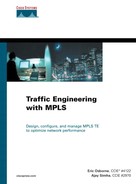Summary
Both IP and MPLS TE reroute if there's a failure somewhere in the network. However, IGP reroute is often not quick enough for real-time applications, and the MPLS TE headend reroute is, if anything, slower than IGP reroute because there's more work to be done.
Real-time applications might require subsecond convergence. FRR is the way to acheive this. Loss is minimized because of the ability to use local failure detection and repair. In the absence of local failure detection and repair, signalling propagation delay might result in packet loss that is unsuitable for real-time applications.
There are two types of local protection: link protection and node protection. Link protection can help only when the link that is downstream of the PLR fails. Node protection protects both the link and the node that are immediately downstream of the PLR.
Local repair is highly scalable because multiple LSPs are protected by a single backup tunnel, as opposed to path protection, which needs one backup tunnel per LSP.
Chapter 9 discusses design issues related to protection.
